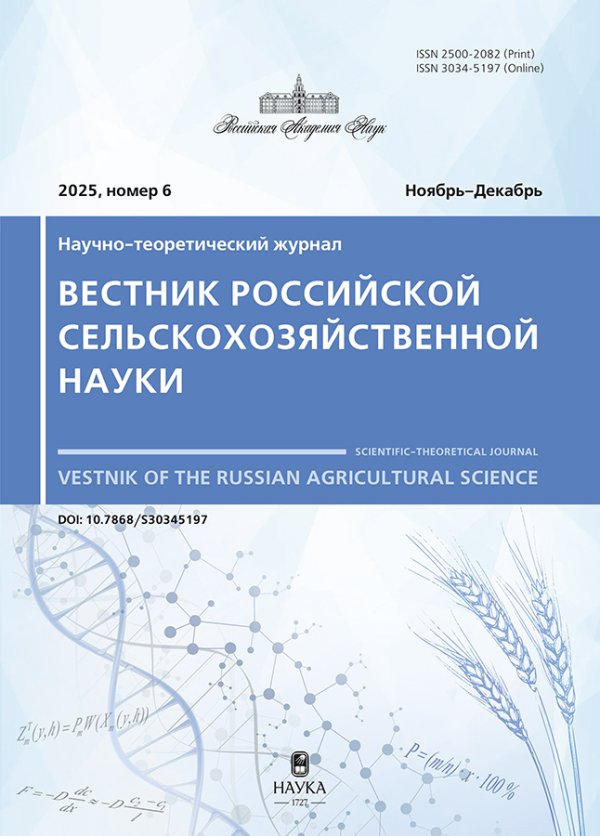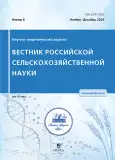Comprehensive Anti-Stress Protection of Grain Crops under Contrasting Weather Conditions
- Authors: Stupin A.S.1, Levin V.I.1
-
Affiliations:
- Ryazan State Agrotechnological University named after P.A. Kostychev
- Issue: No 6 (2024)
- Pages: 55-60
- Section: Crop Production and Selection
- URL: https://ogarev-online.ru/2500-2082/article/view/274484
- DOI: https://doi.org/10.31857/S2500208224060135
- EDN: https://elibrary.ru/WTLIPE
- ID: 274484
Cite item
Abstract
The article presents the results of stress protection of seeds and plants of spring wheat and barley of zoned varieties for the 3rd agro-climatic zone of the Russian Federation. The research was carried out in 2018–2022 in 2 stages: the first was a series of laboratory experiments at the departments of breeding, seed production and Agrotechnology of the Federal State Budgetary Educational Institution of Higher Education, the second was field experiments on gray forest soils of average fertility in an agricultural enterprise named after him. Krupskaya Ryazan region. The algorithm of complex stress protection included a sequential cascade of interrelated agrotechnological techniques: a) a method for selecting the most resistant batches of seeds to ethylene stress for sowing purposes, b) a method for stress protection and increasing the germination of these seeds during post-harvest storage, c) pre-sowing seed treatment and d) plants IV-V stages of organogenesis with multifunctional growth regulators with anti-stress properties (Albite, TPS; Zircon,R; Epin-Extra,R), prolonging the effect of plant protection in critical phases of plant growth and development. During all 5 years of research, which were contrasting in meteorological conditions, the use of seeds with increased stress resistance and functional activity for sowing contributed, on average, to a stable increase in field germination of spring wheat by 2.8–10.6%, barley – 4.2–7.2%, increased shoot formation in the tillering phase of spring wheat by 0.12–0.23 and barley 0.16–0.25% of plants. These processes were most pronounced in spring wheat, in years with increased drought. The plant variants of complex stress protection were characterized by higher photosynthesis productivity, leaf surface index and terrestrial phytomass. A set of techniques that block the development of stress from the initial stages of ontogenesis to the formation of reproductive organs intensified plant growth, provided a higher level of accumulation of productivity resources, contributed to an increase in grain yields of spring wheat and barley, depending on the experimental options, by 0.48–0.62 t/ha and 0.31–0.39 t/ha, respectively. The increase in yield in all the years of the study, when using anti-stress protection, was due to an increase in the number of productive stems, a higher full-weight ear and a weight of 1000 grains. The applied stress protection methods fully meet the requirements of the production of environmentally friendly products and can be used as an element of technology in the production of organic crop products.
Keywords
Full Text
About the authors
A. S. Stupin
Ryazan State Agrotechnological University named after P.A. Kostychev
Author for correspondence.
Email: stupin32@yandex.ru
PhD in Agricultural Sciences, Associate Professor
Russian Federation, RyazanV. I. Levin
Ryazan State Agrotechnological University named after P.A. Kostychev
Email: stupin32@yandex.ru
Grand PhD in Agricultural Sciences, Professor
Russian Federation, RyazanReferences
- Borovskaya A.D., Ivanova R.A., Mashchenko N.E. Vliyanie teplovogo stressa i biologicheski aktivnyh veshchestv iz Linaria genistifolia na prorastanie semyan kukuruzy i soderzhanie v nih krahmala // SECŢIA I. Aspecte genetice şi fiziologice de creare şi dirijare a potenţialului productiv şi adaptiv al plantelor de cultură. 2021. S. 18–21. https://doi.org/10.53040/gppb7.2021.04
- Vakulenko V.V. Vliyanie regulyatorov rosta na urozhajnost’ sel’skohozyajstvennyh kul’tur v razlichnyh zonah Rossii // Zernovoe hozyajstvo Rossii. 2015. № 1. S. 48–54.
- Grabovec A.I., Fomenko M.A. Izmenenie klimata i osobennosti selekcii ozimoj myagkoj pshenicy na produktivnost’ i adaptivnost’ k nemu // Vestnik rossijskoj sel’skohozyajstvennoj nauki. 2023. № 1. S. 20–25.
- Gureeva E.V. Vliyanie gidrotermicheskih uslovij na urozhajnost’ semyan soi v usloviyah Ryazanskoj oblasti // Zemledelie. 2018. № 7. S. 34–35.
- Zemlyanskaya E.V., Omel’yanchuk N.A., Ermakov A.A., Mironova V.V. Mekhanizmy regulyacii peredachi etilenovogo signala u rastenij // Vavilovskij zhurnal genetiki i selekcii. 2016. T. 20. № 3. S. 386–395.
- Ionova E.V., Lihovidova V.A., Lobunskaya I.A. Zasuha i gidrotermicheskij koefficient uvlazhneniya kak odin iz kriteriev ocenki stepeni ee intensivnosti (obzor literatury) // Zernovoe hozyajstvo Rossii. 2019. № 6. S. 18–22.
- Levin V.I., Antipkina L.A., Stupin A.S. Posledejstvie stress-faktorov na prorastanie i posevnye kachestva semyan zernovyh kul’tur // Vestnik Kurganskoj GSHA. 2023. № 4(48). S. 3–10.
- Levin V.I., Dudin N.N., Antipkina L.A., Ushakov R.N. Sostoyanie stressa u semyan hlebnyh zlakov i metodika ego diagnostiki // Vestnik Altajskogo gosudarstvennogo agrarnogo universiteta. 2020. № 5. S. 28–38.
- Luhmenev V.P. Regulyatory rosta i immunostimulyatory nespecificheskogo antistressovogo dejstviya na yarovoj pshenice // Vestnik Rossijskoj akademii sel’skohozyajstvennyh nauk. 2004. № 4. S. 18–20.
- Luhmenev V.P., Nugumanov A.H., Ahmetshin A.I. i dr. Ekologicheskie aspekty ispol’zovaniya himicheskih sredstv zashchity rastenij na yarovom yachmene i pshenice // Izvestiya Orenburgskogo gosudarstvennogo agrarnogo universiteta. 2005. T. 1. S. 58–61.
- Naumov M.M., Zimina T.V., Hryukina E.I., Ryabchinskaya T.A. Rol’ polifunkcional’nyh regulyatorov rosta rastenij v preodolenii gerbicidnogo stressa // Agrohimiya. 2019. № 5. S. 21–28.
- Neverov A.A., Voskobulova N.I., Vereshchagina A.S. Vliyanie obrabotki semyan regulyatorom rosta rastenij Mival-Agro na formirovanie urozhaya zerna kukuruzy v razlichnyh pogodnyh usloviyah // Zhivotnovodstvo i kormoproizvodstvo. 2018. T. 101. № 2. S. 209–217.
- Nefed’eva E.E., Belopuhov S.L., Verhoturov V.V., Lysak V.I. Rol’ fitogormonov v regulyacii prorastaniya semyan // Izvestiya vuzov. Prikladnaya himiya i biologiya. 2013. № 1. S. 61–66.
- Ryadnov A.I., Arylov Yu.N. Povyshenie urozhajnosti yarovoj pshenicy za schet ispol’zovaniya semyan s nizkim urovnem travmirovaniya // Izvestiya Nizhnevolzhskogo agrouniversitetskogo kompleksa: Nauka i vysshee professional’noe obrazovanie. 2022. № 4 (68). S. 45–52.
- Sergeev V.S. Antistressovaya tekhnologiya zashchity sel’skohozyajstvennyh kul’tur // Vestnik Altajskogo gosudarstvennogo agrarnogo universiteta. 2012. № 10 (96). S. 33–36.
- Tyuterev S.L. Fiziologo-biohimicheskie osnovy upravleniya stressoustojchivost’yu rastenij v adaptivnom rastenievodstve // Vestnik zashchity rastenij. 2000. № 1. S. 11–35.
- Chumkina L.V., Abramova L.I., Kolpakova V.V., Topunov A.F. Rol’ fitogormonov v regulyacii ustojchivosti semyan pshenicy, rzhi i tritikale k dejstviyu povyshennyh temperatur pri prorastanii // Prikladnaya biohimiya i mikrobiologiya. 2019. T. 55. № 1. S. 77–85.
- Ihsan M.Z., Khaliq A., Siddiqui M.H. et al. The response of triticum aestivum treated with plant growth regulators to acute day/night temperature rise // Journal of Plant Growth Regulation. 2022. Т. 41. № 5. С. 2020–2033.
- Levin V.I., Antipkina L.A., Stupin A.S., Dudin N. Modifying the effect of stressed spring wheat seeds on intact ones // IOP Conference Series: Earth and Environmental Science, Yekaterinburg. IOP Publishing Ltd: IOP Publishing Ltd, 2021. p. 012015.
- Sabagh A., Islam M.S., Hossain A. et al. Phytohormones as growth regulators during abiotic stress tolerance in plants // Frontiers in Agronomy. 2022. Т. 4. p. 765068.
Supplementary files










